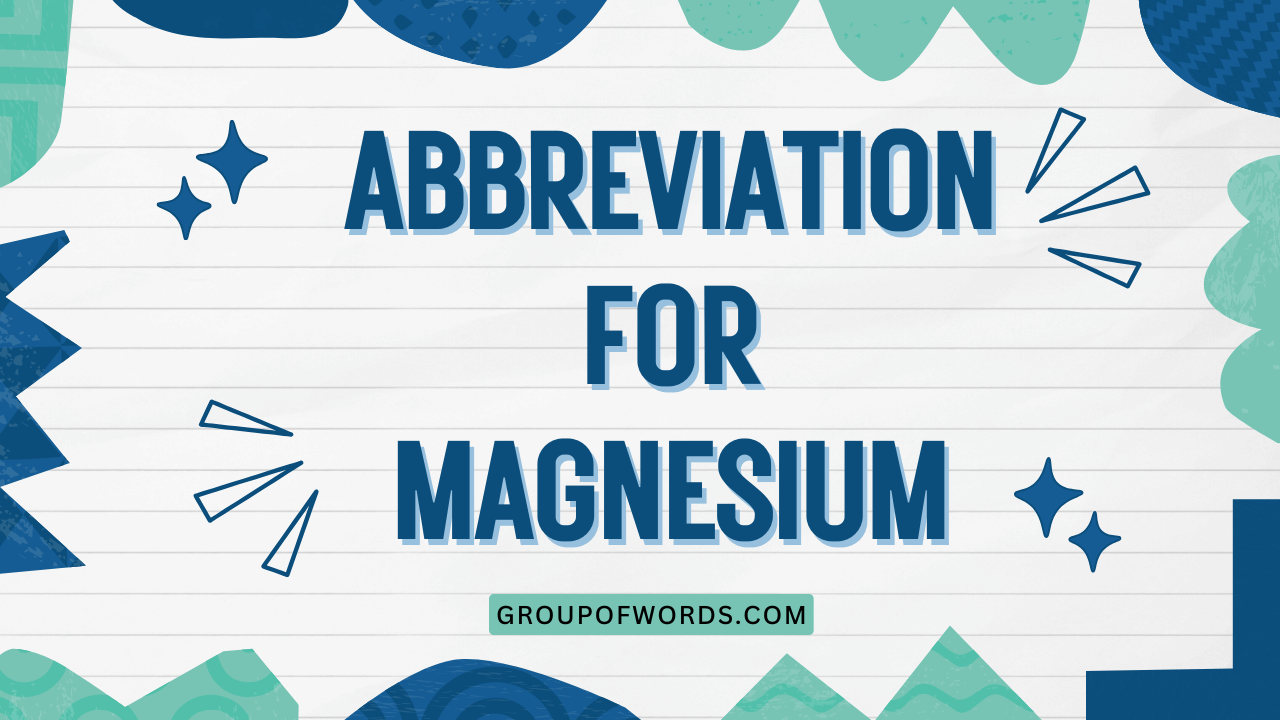Decoding ‘Magnesium’: A Grammar Guide to Its Abbreviation
Understanding abbreviations is crucial for effective communication, especially in scientific and technical fields. This article focuses on the abbreviation for magnesium, a vital element in chemistry and biology.
Mastering this abbreviation enhances understanding in academic, professional, and everyday contexts. This guide will explore the definition, usage, and common errors associated with the abbreviation for magnesium, providing a comprehensive resource for learners of all levels.
Whether you’re a student, a scientist, or simply curious, this article will equip you with the knowledge to confidently use and interpret the abbreviation for magnesium.
This article is designed to provide a comprehensive understanding of the abbreviation for magnesium. By examining its structural components, usage rules, and common mistakes, readers will gain the confidence to use it correctly in various contexts.
The practice exercises included will further solidify your understanding and ability to apply this knowledge effectively. This article is suitable for students, educators, and anyone seeking to improve their understanding of scientific abbreviations.
Table of Contents
- Definition of Magnesium and Its Abbreviation
- Structural Breakdown of ‘Mg’
- Examples of ‘Mg’ in Sentences
- Usage Rules for the Abbreviation ‘Mg’
- Common Mistakes When Using ‘Mg’
- Practice Exercises
- Advanced Topics: Isotopes and Compounds
- Frequently Asked Questions
- Conclusion
Definition of Magnesium and Its Abbreviation
Magnesium (Mg) is a chemical element with the atomic number 12. It’s an alkaline earth metal and is the eighth most abundant element in the Earth’s crust.
Magnesium is essential for various biological functions, including muscle and nerve function, blood sugar control, and blood pressure regulation. It is also crucial for energy production and protein synthesis.
The abbreviation ‘Mg’ is the universally accepted symbol for magnesium in chemistry, physics, and other scientific disciplines.
The abbreviation ‘Mg’ originates from the element’s Latin name, magnesium. This practice of using Latin names for chemical symbols is common in chemistry, ensuring consistency and clarity across different languages. The symbol ‘Mg’ represents a single magnesium atom or can refer to the element in various compounds or contexts. Its use is standardized by international scientific organizations, ensuring that it is universally understood.
Structural Breakdown of ‘Mg’
The abbreviation ‘Mg’ consists of two letters: ‘M’ and ‘g’. The first letter, ‘M’, is always capitalized, while the second letter, ‘g’, is always lowercase.
This capitalization convention is crucial in chemistry to distinguish between different elements, as some elements have similar names or symbols. The capitalization also helps to differentiate between elements and other abbreviations or symbols used in scientific writing.
The structure of ‘Mg’ is simple yet precise. The capital ‘M’ indicates that it is a chemical symbol.
The lowercase ‘g’ further specifies the element. This two-letter combination is unique to magnesium and is not used to represent any other element.
The consistent use of this structure is vital for maintaining accuracy and avoiding confusion in scientific communication.
Examples of ‘Mg’ in Sentences
Here are examples showing how ‘Mg’ is used in various contexts. These examples are categorized to illustrate the diverse applications of the abbreviation in scientific and everyday language.
Pay attention to how ‘Mg’ is used in relation to other chemical symbols, quantities, and contexts.
Examples in Scientific Contexts
The following table provides examples of ‘Mg’ used in scientific research papers, textbooks, and other technical documents. These examples demonstrate the correct usage of the abbreviation in chemical formulas, equations, and descriptive text.
| Context | Example Sentence |
|---|---|
| Chemical Formula | MgO is the chemical formula for magnesium oxide. |
| Chemical Reaction | 2Mg + O2 → 2MgO represents the reaction of magnesium with oxygen. |
| Concentration | The solution contained 50 mg/L of Mg2+ ions. |
| Material Science | Mg alloys are known for their lightweight and high strength. |
| Biochemistry | Mg2+ ions are essential for the activity of many enzymes. |
| Geology | The rock sample contained a significant amount of Mg silicate. |
| Spectroscopy | The emission spectrum showed a strong peak for Mg at 285 nm. |
| Medicine | The patient was prescribed Mg supplements to treat the deficiency. |
| Agriculture | Soil testing revealed a low level of available Mg for plant uptake. |
| Environmental Science | The concentration of Mg in the river water was monitored regularly. |
| Solid State Physics | The crystal structure of Mg exhibits hexagonal close-packed arrangement. |
| Electrochemistry | Mg is used as the anode material in certain types of batteries. |
| Quantum Mechanics | The electronic configuration of Mg is 1s22s22p63s2. |
| Nuclear Physics | Mg-24 is a stable isotope of magnesium. |
| Analytical Chemistry | Atomic absorption spectroscopy was used to determine the Mg content. |
| Organic Chemistry | Grignard reagents, which contain Mg, are useful in organic synthesis. |
| Inorganic Chemistry | Mg(OH)2 is commonly known as milk of magnesia. |
| Nanotechnology | Mg nanoparticles are used in various biomedical applications. |
| Thermodynamics | The enthalpy of formation of MgO is -601.6 kJ/mol. |
| Cosmochemistry | The abundance of Mg in stars can be determined through spectral analysis. |
| Astrophysics | Mg lines are observed in the spectra of many celestial objects. |
| Oceanography | The concentration of Mg in seawater is relatively constant. |
| Metallurgy | Mg is added to aluminum alloys to improve their strength and corrosion resistance. |
| Engineering | Mg alloys are used in aerospace applications due to their low density. |
Examples in Medical Contexts
The following table provides examples of ‘Mg’ used in medical reports, prescriptions, and patient education materials. These examples demonstrate the importance of magnesium in human health and the correct usage of the abbreviation in medical contexts.
| Context | Example Sentence |
|---|---|
| Prescription | The doctor prescribed 250 mg of Mg oxide daily. |
| Blood Test | The blood test revealed a low Mg level. |
| Supplement | The patient was advised to take an Mg supplement. |
| Medical Report | The serum Mg concentration was found to be 1.8 mg/dL. |
| Deficiency Symptoms | Muscle cramps can be a sign of Mg deficiency. |
| Treatment | Intravenous Mg sulfate was administered to treat the arrhythmia. |
| Dietary Intake | Ensure adequate Mg intake through diet. |
| Pregnancy | Mg supplementation is often recommended during pregnancy. |
| Cardiology | Mg plays a role in maintaining heart rhythm. |
| Neurology | Mg is important for nerve function. |
| Endocrinology | Mg influences insulin sensitivity. |
| Gastroenterology | Mg hydroxide is used as a laxative. |
| Nephrology | Mg excretion is regulated by the kidneys. |
| Pediatrics | Mg requirements vary with age in children. |
| Geriatrics | Mg absorption may decrease in older adults. |
| Pharmacology | The bioavailability of different Mg salts varies. |
| Toxicology | Excessive Mg intake can lead to diarrhea. |
| Emergency Medicine | Mg sulfate is used to treat eclampsia. |
| Nursing | Monitor patients receiving intravenous Mg for side effects. |
| Public Health | Mg deficiency is a common nutritional problem. |
| Sports Medicine | Mg is important for muscle recovery after exercise. |
| Alternative Medicine | Some believe Mg oil can be absorbed through the skin. |
| Dentistry | Mg plays a role in bone health. |
| Ophthalmology | Mg may help prevent glaucoma. |
Examples in Everyday Contexts
The following table provides examples of ‘Mg’ used in everyday conversations, news articles, and product descriptions. These examples demonstrate how the abbreviation is used in non-scientific contexts, often in relation to health and nutrition.
| Context | Example Sentence |
|---|---|
| Nutrition Labels | This cereal contains 10% of your daily recommended Mg intake. |
| Health Articles | Studies show that Mg can help reduce stress. |
| Product Descriptions | Our supplement provides 500 mg of elemental Mg per serving. |
| Conversations | “I’ve been taking Mg supplements for my muscle cramps.” |
| News Reports | The new study highlights the importance of Mg in preventing heart disease. |
| Advertisements | Boost your energy levels with our Mg-rich formula. |
| Blogs | Learn about the benefits of Mg for your health. |
| Social Media | Did you know that dark chocolate is a good source of Mg? |
| Cooking | Spinach is a great source of Mg. |
| Gardening | Epsom salt (magnesium sulfate) can help plants grow. |
| Fitness | Mg helps with muscle recovery after workouts. |
| Wellness | Taking an Mg bath can help you relax. |
| DIY Projects | Epsom salt (Mg sulfate) can be used in homemade bath bombs. |
| Skincare | Mg is sometimes added to skincare products. |
| Pet Care | Some pet foods contain added Mg. |
| Home Improvement | Mg oxide is used in some types of cement. |
| Automotive | Mg alloys are used in some car parts. |
| Sports Equipment | Mg chalk is used by weightlifters to improve grip. |
| Electronics | Mg is used in some types of batteries. |
| Camping | Mg fire starters are used in survival kits. |
| Photography | Mg flashbulbs were used in early photography. |
| Fireworks | Mg is used to create bright white sparks in fireworks. |
| Aerospace | Mg alloys are used in aircraft construction. |
Usage Rules for the Abbreviation ‘Mg’
The abbreviation ‘Mg’ follows specific rules to ensure correct usage in scientific and technical writing. Adhering to these rules maintains clarity and consistency.
Here’s a breakdown of the key rules:
- Capitalization: Always capitalize the first letter (‘M’) and use lowercase for the second letter (‘g’). This is a strict rule and must be followed in all contexts.
- Context: Use ‘Mg’ in scientific and technical contexts where it is necessary to refer to the element magnesium. In general writing, it’s often better to spell out “magnesium” unless space is limited or the context is highly technical.
- Superscripts and Subscripts: When referring to magnesium ions, use superscripts to indicate the charge (e.g., Mg2+). When referring to isotopes, use superscripts before the symbol to indicate the mass number (e.g., 24Mg). Subscripts can be used to indicate the number of magnesium atoms in a chemical formula (e.g., MgCl2).
- Spacing: When used with numbers, leave a space between the number and the abbreviation (e.g., 50 mg). When used in chemical formulas, do not include spaces (e.g., MgO).
- Units: When expressing quantities, use appropriate units (e.g., mg for milligrams, g for grams, mol for moles).
Following these rules ensures that your use of the abbreviation ‘Mg’ is accurate and consistent with scientific conventions. Consistency is key to clear and effective communication in scientific and technical fields.
Common Mistakes When Using ‘Mg’
Even with a seemingly simple abbreviation like ‘Mg’, mistakes can occur. Being aware of these common errors can help you avoid them.
Here are some frequent mistakes and how to correct them:
| Incorrect | Correct | Explanation |
|---|---|---|
| mg | Mg | The first letter must be capitalized. |
| MG | Mg | Only the first letter should be capitalized. |
| Mg. | Mg | Do not add a period after the abbreviation unless it ends a sentence. |
| Mag | Mg | ‘Mag’ is not the correct abbreviation for magnesium. |
| 50mg | 50 mg | Leave a space between the number and the abbreviation. |
| Mg+2 | Mg2+ | Use a superscript to indicate the charge of the ion. |
| 24Mg | 24Mg | Use a superscript before the symbol to indicate the mass number of the isotope. |
| Mg Cl2 | MgCl2 | Do not include spaces within chemical formulas. |
| Magnesium | Mg | While technically not incorrect, using the full name where the abbreviation is appropriate can make the text less concise. Use the abbreviation in technical contexts. |
By being mindful of these common mistakes, you can ensure that your use of ‘Mg’ is accurate and professional. Correcting these errors will improve the clarity and credibility of your writing.
Practice Exercises
Test your understanding of the abbreviation ‘Mg’ with these practice exercises. Fill in the blanks with the correct abbreviation or correct the sentences as needed.
Exercise 1: Fill in the Blanks
| Question | Answer |
|---|---|
| The chemical symbol for magnesium is ______. | Mg |
| ______ ions are essential for many enzymatic reactions. | Mg2+ |
| ______ oxide is a common antacid. | MgO |
| The patient was prescribed 200 ______ of magnesium. | mg |
| ______ is an alkaline earth metal. | Mg |
| ______ deficiency can lead to muscle cramps. | Mg |
| ______ is lighter than aluminum. | Mg |
| ______ is important for bone health. | Mg |
| ______ is used in fireworks to create bright white sparks. | Mg |
| The isotope ______ is stable. | 24Mg |
Exercise 2: Correct the Sentences
| Question | Answer |
|---|---|
| mg is essential for plant growth. | Mg is essential for plant growth. |
| The blood test showed a low MG level. | The blood test showed a low Mg level. |
| Take 250 mg. of magnesium daily. | Take 250 mg of magnesium daily. |
| The formula is MgCl 2. | The formula is MgCl2. |
| The solution contained 100 mag/L of magnesium. | The solution contained 100 Mg/L of magnesium. |
| The concentration of magnesium+2 ions was high. | The concentration of Mg2+ ions was high. |
| Isotope 24Mg is abundant. | Isotope 24Mg is abundant. |
| The doctor prescribed Magnesium. | The doctor prescribed Mg. (in a technical context) |
| The patient took 500mg of the supplement. | The patient took 500 mg of the supplement. |
| Mag is a light metal. | Mg is a light metal. |
Exercise 3: Multiple Choice
| Question | Answer |
|---|---|
| What is the correct abbreviation for magnesium? a) mg b) MG c) Mg d) Mag |
c) Mg |
| How should you represent a magnesium ion with a +2 charge? a) Mg+2 b) Mg+2 c) Mg2+ d) Mg2+ |
d) Mg2+ |
| Which of the following is the correct way to write “50 milligrams of magnesium”? a) 50mg b) 50 mg c) 50Mg d) 50 Mg. |
b) 50 mg |
| What does MgO represent? a) Magnesium gas b) Magnesium oxide c) Magnesium ore d) Magnesium alloy |
b) Magnesium oxide |
| Which of the following is a common use of magnesium? a) As a fuel b) As a building material c) As a dietary supplement d) As a refrigerant |
c) As a dietary supplement |
| What is the atomic number of magnesium? a) 10 b) 11 c) 12 d) 13 |
c) 12 |
| Which field most commonly uses the abbreviation ‘Mg’? a) History b) Literature c) Chemistry d) Art |
c) Chemistry |
| What form of magnesium is often used in supplements? a) MgCl b) MgO c) MgSO4 d) All of the above |
d) All of the above |
| In what part of the periodic table is magnesium found? a) Alkali metals b) Alkaline earth metals c) Halogens d) Noble gases |
b) Alkaline earth metals |
| Which isotope of magnesium is the most common? a) 23Mg b) 24Mg c) 25Mg d) 26Mg |
b) 24Mg |
Advanced Topics: Isotopes and Compounds
For advanced learners, understanding the isotopes and compounds of magnesium adds another layer of complexity. This section delves into these topics, providing a more in-depth understanding of magnesium’s role in various scientific contexts.
Magnesium Isotopes
Magnesium has several isotopes, with three stable isotopes occurring naturally: 24Mg, 25Mg, and 26Mg. 24Mg is the most abundant, accounting for about 79% of naturally occurring magnesium. The other isotopes are present in smaller amounts. These isotopes have different nuclear properties, which can be important in certain scientific applications, such as isotope tracing and nuclear medicine.
The notation for isotopes involves placing the mass number (the total number of protons and neutrons in the nucleus) as a superscript before the element symbol (e.g., 24Mg). This notation is crucial for distinguishing between different isotopes of the same element. Understanding isotopes is essential for advanced studies in chemistry, physics, and related fields.
Magnesium Compounds
Magnesium forms a wide variety of compounds with different properties and uses. Some common magnesium compounds include magnesium oxide (MgO), magnesium chloride (MgCl2), and magnesium sulfate (MgSO4). Magnesium oxide is used as a refractory material and in antacids. Magnesium chloride is used in de-icing and dust control. Magnesium sulfate, also known as Epsom salt, is used in bath salts and as a laxative.
The chemical formulas for magnesium compounds follow specific rules of chemical nomenclature. These rules dictate the order in which elements are written and the use of subscripts to indicate the number of atoms of each element in the compound.
Understanding these rules is essential for correctly interpreting and writing chemical formulas.
Frequently Asked Questions
Here are some frequently asked questions about the abbreviation ‘Mg’ and its usage:
- Why is ‘Mg’ the abbreviation for magnesium?
The abbreviation ‘Mg’ is derived from the Latin name for magnesium, magnesium. The use of Latin names for element symbols is a standard practice in chemistry to ensure consistency across different languages.
- Is it ever appropriate to write ‘mg’ instead of ‘Mg’?
No, ‘mg’ (lowercase ‘m’) is the abbreviation for milligram, a unit of mass. ‘Mg’ (capital ‘M’) is the correct abbreviation for the element magnesium. Using ‘mg’ instead of ‘Mg’ would be a mistake and could lead to confusion.
- How do I write the symbol for a magnesium ion with a +2 charge?
The correct way to write the symbol for a magnesium ion with a +2 charge is Mg2+. The ‘2+’ is written as a superscript to indicate the positive charge of the ion.
- Do I need to put a space between a number and ‘Mg’?
Yes, a space should be included between a number and ‘Mg’ when expressing a quantity (e.g., 50 mg). However, no space is needed within a chemical formula (e.g., MgO).
- Can I use ‘Mg’ in everyday writing, or is it only for scientific contexts?
While ‘Mg’ is primarily used in scientific and technical contexts, it is acceptable to use it in everyday writing when referring to magnesium in health-related articles, nutrition labels, or product descriptions. However, in general writing, it’s often better to spell out “magnesium” for clarity.
- What are some common compounds that contain magnesium (Mg)?
Some common compounds that contain magnesium include magnesium oxide (MgO), magnesium chloride (MgCl2), and magnesium sulfate (MgSO4). These compounds have various uses, ranging from antacids to de-icing agents.
- Are there different isotopes of magnesium, and how are they written?
Yes, magnesium has several isotopes, including 24Mg, 25Mg, and 26Mg. The mass number (the total number of protons and neutrons in the nucleus) is written as a superscript before the element symbol.
- What should I do if I’m unsure whether to use ‘Mg’ or spell out “magnesium”?
If you’re unsure whether to use ‘Mg’ or spell out “magnesium,” consider your audience and the context of your writing. In technical documents, ‘Mg’ is generally preferred. In more general writing, spelling out “magnesium” may be clearer for readers unfamiliar with chemical abbreviations.
Conclusion
Mastering the abbreviation ‘Mg’ is essential for effective communication in scientific and technical fields. This article has provided a comprehensive guide to understanding its definition, structure, usage rules, and common mistakes.
By following these guidelines and practicing the exercises, you can confidently use and interpret the abbreviation ‘Mg’ in various contexts. Remember to always capitalize the ‘M’ and use lowercase for the ‘g’, and be mindful of the context in which you are using the abbreviation.
In conclusion, the abbreviation ‘Mg’ for magnesium is a fundamental concept in chemistry and related fields. Its consistent and correct usage is crucial for clear and accurate communication.
By understanding the rules and conventions outlined in this article, you can enhance your understanding of scientific literature and improve your writing skills. Keep practicing and applying these concepts to further solidify your knowledge.






